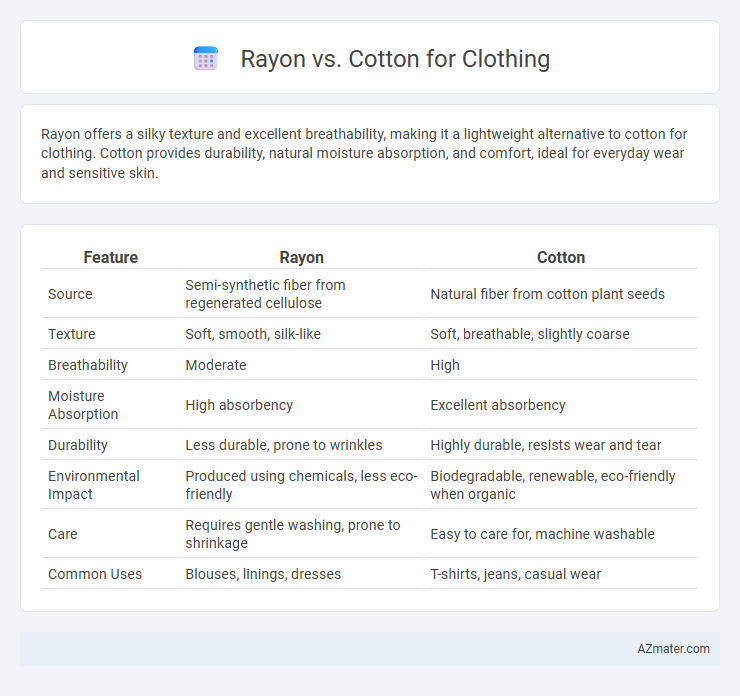Rayon offers a silky texture and excellent breathability, making it a lightweight alternative to cotton for clothing. Cotton provides durability, natural moisture absorption, and comfort, ideal for everyday wear and sensitive skin.
Table of Comparison
| Feature | Rayon | Cotton |
|---|---|---|
| Source | Semi-synthetic fiber from regenerated cellulose | Natural fiber from cotton plant seeds |
| Texture | Soft, smooth, silk-like | Soft, breathable, slightly coarse |
| Breathability | Moderate | High |
| Moisture Absorption | High absorbency | Excellent absorbency |
| Durability | Less durable, prone to wrinkles | Highly durable, resists wear and tear |
| Environmental Impact | Produced using chemicals, less eco-friendly | Biodegradable, renewable, eco-friendly when organic |
| Care | Requires gentle washing, prone to shrinkage | Easy to care for, machine washable |
| Common Uses | Blouses, linings, dresses | T-shirts, jeans, casual wear |
Introduction to Rayon and Cotton
Rayon is a semi-synthetic fiber made from regenerated cellulose derived from wood pulp, known for its silk-like feel and breathability. Cotton, a natural fiber harvested from the seeds of the cotton plant, is prized for its softness, durability, and moisture-absorbing properties. Both fibers are widely used in clothing for their comfort, but they differ in texture, environmental impact, and maintenance requirements.
Origins and Production Processes
Rayon, a semi-synthetic fiber derived from cellulose found in wood pulp, undergoes chemical treatments and regeneration to transform natural materials into versatile fabric, while cotton is a natural fiber harvested directly from cotton plants and spun into yarn through mechanical processing. The production of rayon involves dissolving cellulose in chemicals like sodium hydroxide and carbon disulfide before extruding it into fibers, contrasting with cotton's cultivation, ginning, and carding processes that retain its natural plant-based properties. These fundamental differences in origins and manufacturing impact the texture, breathability, and sustainability profiles of rayon and cotton fabrics in clothing.
Texture and Feel: Comfort Comparison
Rayon offers a smooth, silky texture that feels cool and breathable against the skin, making it ideal for lightweight summer clothing. Cotton provides a soft, natural feel with excellent moisture absorption, offering comfort and durability for everyday wear. Both fibers enhance comfort, but rayon's silky finish contrasts with cotton's breathable, slightly textured surface.
Durability and Longevity
Rayon fabric, made from regenerated cellulose fibers, tends to be less durable than cotton due to its lower tensile strength and susceptibility to weakening when wet. Cotton, a natural fiber known for its robustness, offers superior longevity and withstands repeated washing and wear without significant degradation. Choosing cotton for clothing ensures greater durability and a longer lifespan, especially in garments subjected to frequent use.
Breathability and Moisture Absorption
Rayon offers excellent breathability due to its semi-synthetic cellulose fibers, allowing air to circulate and keeping the body cool in warm weather. Cotton excels in moisture absorption, capable of holding up to 27 times its weight in water, which helps wick sweat away from the skin for comfort. Both fabrics provide good ventilation, but cotton's natural fibers generally deliver superior moisture management compared to rayon.
Environmental Impact and Sustainability
Rayon, a semi-synthetic fiber derived from cellulose, typically uses chemically intensive processes and significant water consumption, raising concerns about its environmental footprint compared to cotton. Cotton cultivation demands large amounts of water and pesticides, but organic cotton reduces these impacts through sustainable farming practices. Choosing sustainably sourced cotton or innovative, eco-friendly rayon variants can minimize environmental harm while supporting clothing industry sustainability efforts.
Ease of Care and Maintenance
Rayon clothing requires gentle washing and air drying to prevent shrinking and maintain fabric softness, making it less convenient for everyday care compared to cotton. Cotton is highly durable, withstands machine washing and drying, and tends to become softer with each wash, making it a practical choice for easy maintenance. Both fibers benefit from ironing to reduce wrinkles, but cotton typically resists damage from higher heat settings better than rayon.
Cost Differences and Affordability
Rayon fabric typically costs less to produce than cotton due to its semi-synthetic manufacturing process, leading to more affordable clothing options. Cotton, especially organic or high-quality varieties, tends to be pricier because of its natural cultivation and longer production cycles. Consumers seeking budget-friendly apparel often choose rayon for its lower cost, while those prioritizing breathability and natural fibers may invest more in cotton garments.
Common Uses in Fashion
Rayon, known for its silky texture and excellent drape, is commonly used in fashion for flowy dresses, blouses, and linings due to its ability to mimic natural fibers like silk and cotton. Cotton is favored for everyday clothing such as t-shirts, jeans, and casual wear because of its breathability, durability, and moisture-wicking properties. Both fabrics serve distinct purposes in fashion, with rayon excelling in lightweight, elegant apparel and cotton dominating comfort-focused, versatile garments.
Choosing Between Rayon and Cotton: Key Considerations
Rayon offers a silky texture and excellent drape, making it ideal for stylish, lightweight clothing, while cotton provides superior breathability and durability, perfect for everyday wear and sensitive skin. Consider moisture absorption; cotton excels at moisture wicking, enhancing comfort in hot climates, whereas rayon tends to retain moisture, potentially feeling heavier when wet. Environmental impact should influence your choice--cotton is a natural fiber with biodegradable properties, whereas rayon, though derived from cellulose, involves chemical processing that can affect sustainability.

Infographic: Rayon vs Cotton for Clothing
 azmater.com
azmater.com